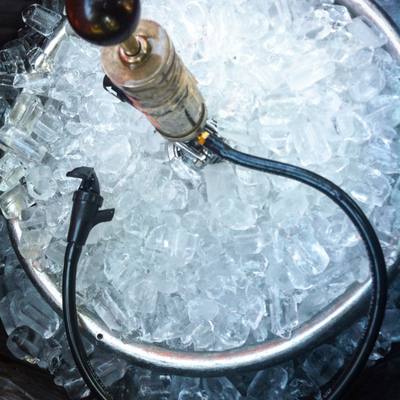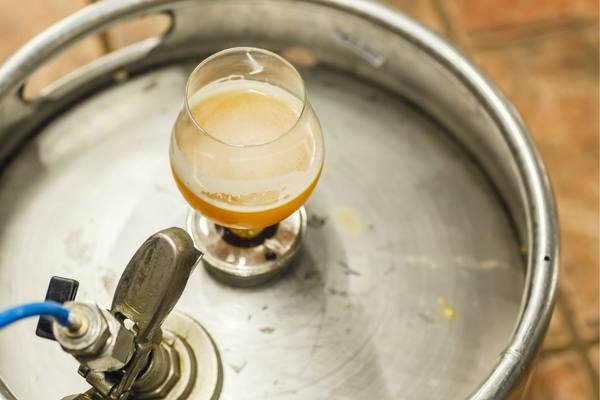Yes, you can retap a keg. If you have a keg that has not been completely emptied, you can retap it to get the remaining beer out. However, it is important to follow proper procedures and take necessary precautions to ensure the beer remains fresh and the keg doesn’t get damaged.
In the world of beer brewing and kegging, there are many questions that may arise, especially for those who are new to the process.
In this blog post, we will explore this question in depth, drawing from both expert knowledge and personal experience.
We will discuss various aspects of retapping a keg, including reasons for doing so, potential issues, and proper techniques. Let’s dive in!
1. Why Retap a Keg?
There are several reasons why someone might need or want to retap a keg. The most common reason is that there is still beer left in the keg after a party or event, and the host wants to save it for later use.
In this case, retapping the keg can help preserve the freshness of the remaining beer and prevent it from going to waste.
Another reason could be that the initial tapping was not done correctly, leading to excess foam and poor beer flow. Retapping may resolve the issue and improve the overall quality of the beer being served.
2. Potential Issues with Re-tapping a Keg
While retapping a keg is possible and often necessary, there are some potential issues that can arise if it is not done correctly.
One such issue is the introduction of bacteria or other contaminants into the keg, which can spoil the beer and make it unsafe to drink.
Another issue is the possibility of damaging the keg or its components, such as the coupler or the pressure relief valve, which can lead to leaks or other problems.
3. Selecting the Right Equipment
Before retapping a keg, it is important to ensure that you have the appropriate equipment on hand. This includes a keg coupler that is compatible with the type of keg you are using, as well as a CO2 tank and regulator to maintain proper pressure. Additionally, you will need a faucet and beer line to dispense the beer, and a drip tray to catch any spills or drips.
4. Proper Sanitation Procedures
One key aspect of retapping a keg is maintaining proper sanitation throughout the process. This helps to prevent the introduction of bacteria, yeast, or other contaminants that can spoil the beer. Before retapping, thoroughly clean and sanitize all equipment that will come into contact with the beer, including the coupler, beer line, faucet, and drip tray. You can use a commercial sanitizer or a solution of warm water and bleach to clean your equipment.
5. Proper Retapping Technique
When retapping a keg, it is important to follow the correct procedure to prevent damage to the keg and ensure a good seal. First, make sure the CO2 tank is turned off and the regulator pressure is set to zero.
Next, align the coupler with the keg valve and press down firmly, twisting it into place until it locks. Be careful not to overtighten, as this can damage the valve.

Once the coupler is securely attached, connect the CO2 line and beer line, and slowly turn up the pressure on the regulator while monitoring for any leaks. Finally, open the faucet to dispense the beer.
6. Maintaining Proper Pressure
When retapping a keg, it is important to maintain proper pressure to ensure the beer remains fresh and carbonated. The ideal serving pressure for most beers is between 10 and 12 PSI, although this can vary depending on the specific beer and personal preferences. Monitor the pressure regularly and make adjustments as necessary to maintain the desired level of carbonation.
7. Monitoring Beer Quality
After retapping a keg, it is essential to monitor the quality of the beer to ensure it remains fresh and safe to drink. Keep an eye out for any changes in the appearance, smell, or taste of the beer, which may indicate spoilage or contamination. If you notice any off-flavors or signs of spoilage, it is best to dispose of the remaining beer and thoroughly clean and sanitize your equipment before using it again.
8. Storing a Retapped Keg
If you need to store a retapped keg for an extended period, it is important to keep it in a cool, dark place, ideally at a temperature between 34 and 38 degrees Fahrenheit. This will help to maintain the beer’s freshness and prevent it from becoming overly carbonated. Additionally, periodically check the pressure and make any necessary adjustments to ensure the beer remains properly carbonated.
9. When to Replace a Keg
In some cases, it may be more practical to replace a keg rather than retapping it. This may be necessary if the keg is damaged or leaking, or if the beer inside has become spoiled or contaminated. Additionally, if you find that you are frequently retapping kegs and struggling to maintain the quality of the beer, it may be more cost-effective to invest in a larger or more efficient keg system.
Conclusion
In conclusion, retapping a keg is possible and often necessary to preserve the freshness of the remaining beer. By following proper procedures and taking necessary precautions, you can ensure that the beer remains fresh and the keg doesn’t get damaged.
Here are the top 10 facts about retapping a keg:
1. You can retap a keg if there is still beer left after an event.
2. Proper sanitation is crucial to prevent spoilage and contamination.
3. Selecting the right equipment is essential to ensure a good seal and prevent leaks.
4. Maintaining proper pressure helps to preserve the beer’s freshness and carbonation.
5. Monitoring the beer’s quality is important to ensure it remains safe to drink.
6. Storing a retapped keg in a cool, dark place will help to maintain its freshness.
7. Proper retapping technique can help to prevent damage to the keg and its components.
8. Adjusting the pressure on the regulator can help to achieve the desired level of carbonation.
9. In some cases, it may be more practical to replace a keg rather than retapping it.
10. Retapping a keg can help to prevent beer waste and save money in the long run.
FAQs
Can you save a keg after opening?
Yes, you can save a keg after opening by properly storing it in a cool place and using a keg tap system with a CO2 cartridge to prevent the beer from going flat. It is important to consume the beer within a few weeks to ensure freshness and quality.
How do you store an open keg of beer?
An open keg of beer should be kept refrigerated and pressurized with carbon dioxide to prevent oxidation and spoilage. The beer should be consumed within a few days to ensure freshness.
Can a keg go from cold to warm to cold?
It is not recommended to repeatedly change the temperature of a keg from cold to warm and back to cold, as it can cause the beer to become stale and affect the quality and taste of the beer. It is best to keep the keg at a consistent temperature throughout its use.
What do you do with empty beer kegs?
Empty beer kegs can be returned to the brewery or distributor for cleaning and refilling, or they can be sold or recycled for scrap metal.
Can beer kegs be reused?
Yes, beer kegs can be reused. They are designed to be durable and withstand multiple uses. After a keg has been emptied, it can be cleaned and sanitized before being refilled with beer. This process can be repeated many times before the keg needs to be retired.
Can I tap keg twice?
Yes, you can tap a keg twice as long as it has not been fully emptied and the beer has not gone bad. However, it is important to ensure that the first tap was properly sealed and that the keg has been stored at the correct temperature to maintain the quality of the beer.




